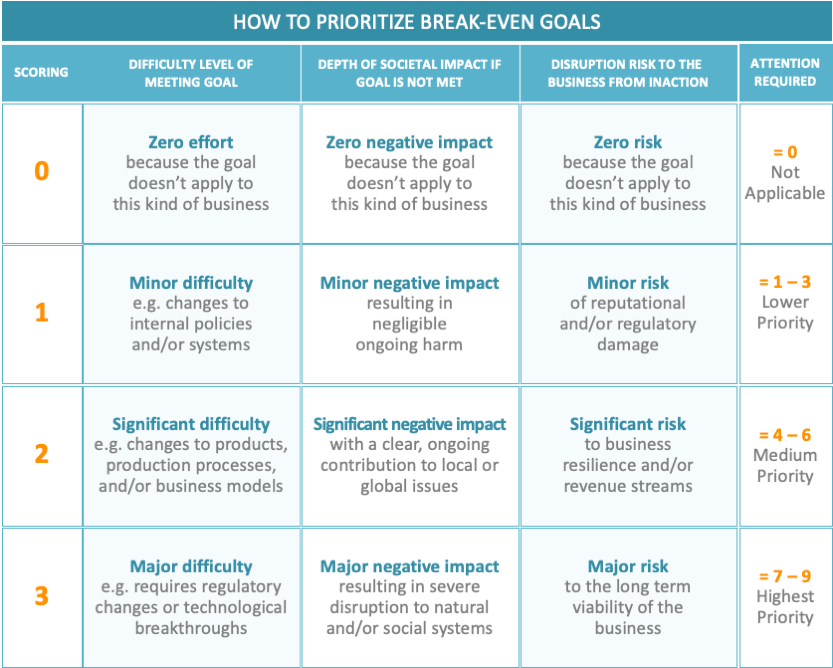
It’s time for a reverse materiality assessment — rather than trying to divine what matters most by forecasting from the unsustainable present, we must prioritize by back-casting from the sustainable future.
One of the most commonly used tools in the CSR professional’s toolkit is the materiality assessment, an exercise in gathering insight on the relative importance of social and environmental issues as a means to inform reporting and strategy development. And yet the way such assessments are conducted often seems to be more of an art than a science. A recent article in Sustainable Brands highlighted some of the key flaws, from focusing on the wrong questions and factoring in only limited stakeholder views, to looking only a short way into the future.
Broadly speaking, a traditional materiality assessment starts by asking “where are we now, and given what our stakeholders are saying, what should we do next?” And the results are typically in the form of a few well-meaning targets that promise gradual gains on a handful of hot-button issues.
Given the urgency of the challenges we face, this incremental approach simply isn’t enough – both in terms of making meaningful progress, and in terms of convincing investors and others that the business is charting a path to long-term success.
Time for a new approach
So, it’s time for companies to ask themselves a new question: “where do we need to be, to ensure our success supports a flourishing society, and how can we get there?” We might think of this as a reverse materiality assessment: rather than trying to divine what matters most by forecasting from the unsustainable present, we must prioritize by back-casting from the sustainable future.
This process has to start with a clear understanding of what the sustainable future requires, and that’s where the Future-Fit Business Benchmark comes in. It offers 23 Break-Even Goals that together identify the line in the sand any company must reach, to be sure it is in no way undermining our social fabric or the natural systems we depend on. Whereas traditional materiality assessments start with a blank sheet of paper and populate it with the issues the business and stakeholders care about, the aim here is to start with the same set of 23 Break-Even Goals, and then figure out which ones deserve most attention, and why.
For each goal, this involves thinking critically about three questions:
1. How difficult will it be for the business to reach the goal?
2. How much could society be impacted if the goal is not reached?
3. How much risk could the business be exposed to if the goal is not pursued?
We’ll look at each of these in turn.
1: How difficult will it be for the business to reach the goal?
When exploring this question, companies should set aside any concerns about whether the business has sufficient budget, or how much the CEO cares about an issue. The focus here is on whether the goal is difficult to reach in principle, given the nature of the business’s products, its revenue models, operational activities, and so on.
2: How much could society be impacted if the goal is not reached?
Again, the focus should be on how much society is impacted in principle. For example, is an issue so tied up with the core business that if the company were to double in size the impact would double too? Are a handful of people being impacted, or is the company contributing to a global problem?
3: How much risk could the business be exposed to if the goal is not pursued?
This question probes into what the risk of inaction would be. Is the issue something which, if unaddressed, could result in significant reputational damage? Could regulations come into force which would leave the company unprepared and potentially unable to sell its products? Could competitors solve the issue, leaving the company racing to catch up?
Getting started
By exploring these questions, companies can quickly identify which of the 23 Future-Fit Break-Even Goals require the most attention, and why. The table below offers a simple scoring matrix which can help you ascribe a relative level of priority to each goal.

Try going through this exercise in your own business: the results may surprise you. We know of a number of companies that have applied this approach to help them highlight the ‘elephant in the room’ issues they face – those seemingly intractable challenges that pointed to fundamental vulnerabilities in their business models. In several of these cases, the CSR team was already aware of the significance of the issues concerned but applying a Future-Fit lens helped them to surface and discuss those issues constructively with company leadership.
The Future-Fit team will soon be publishing a “Workshop in a Box” – a suite of materials to help people to run through this reverse materiality exercise in a team setting. If you’re interested in trying out the pre-release version of this tool now, and giving us feedback on how it goes, then please get in touch!



